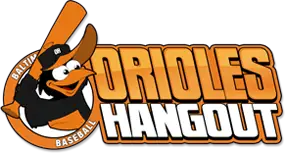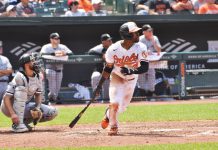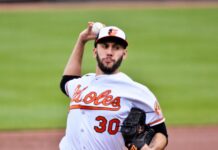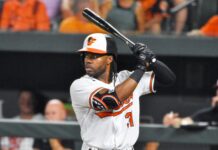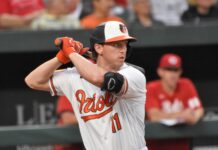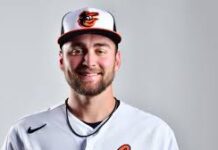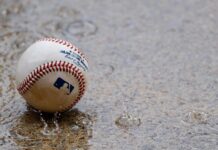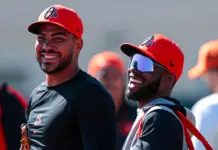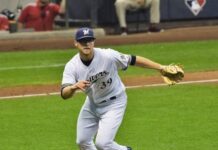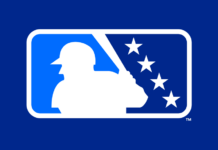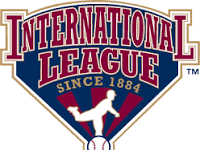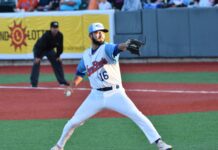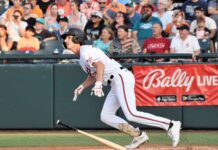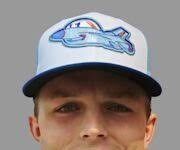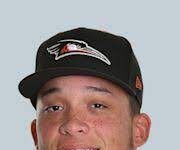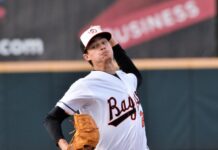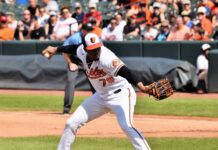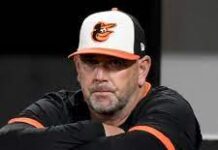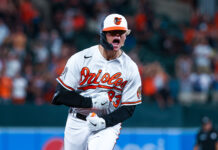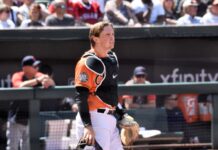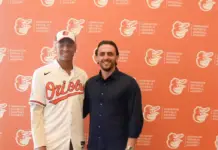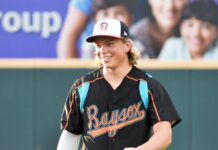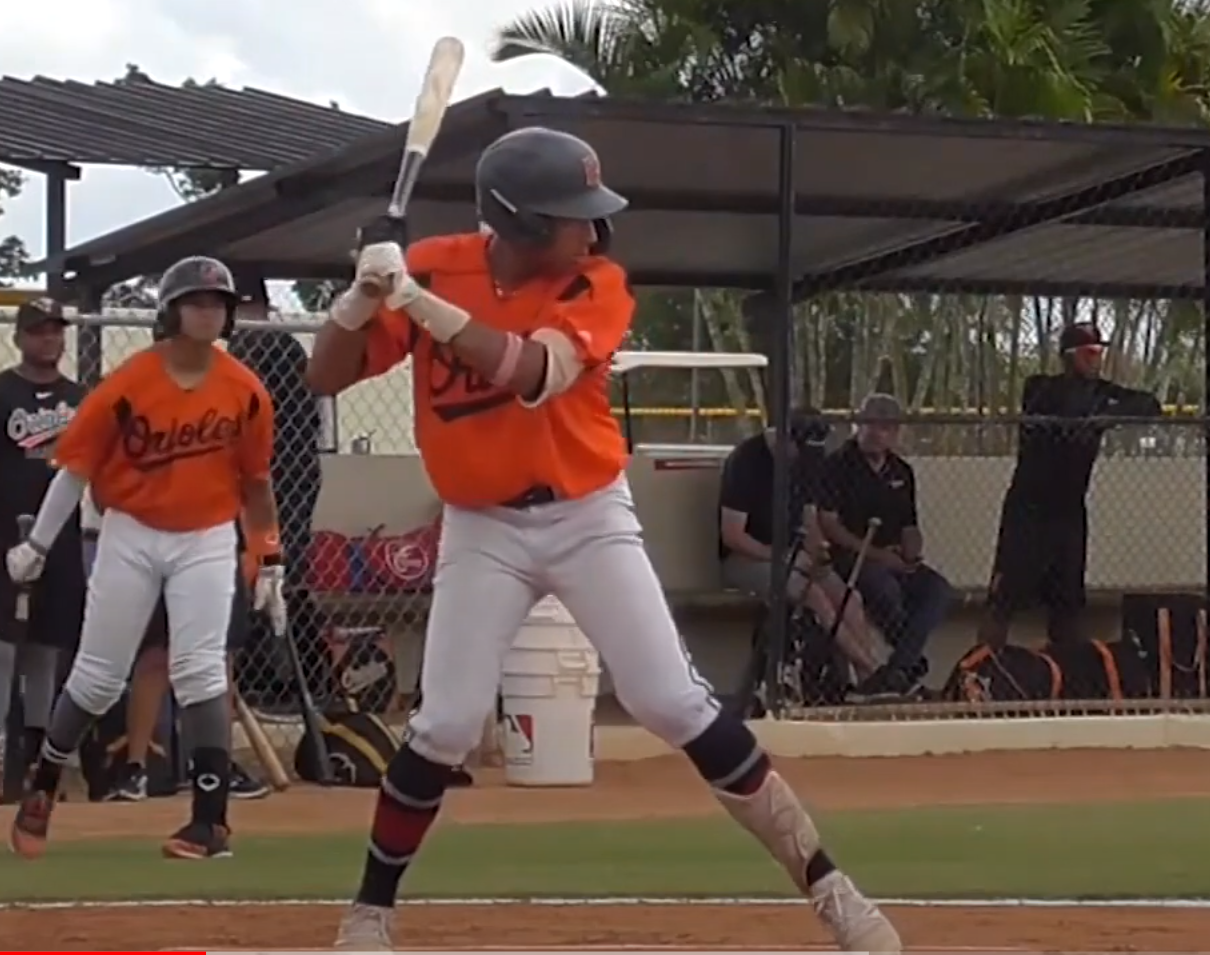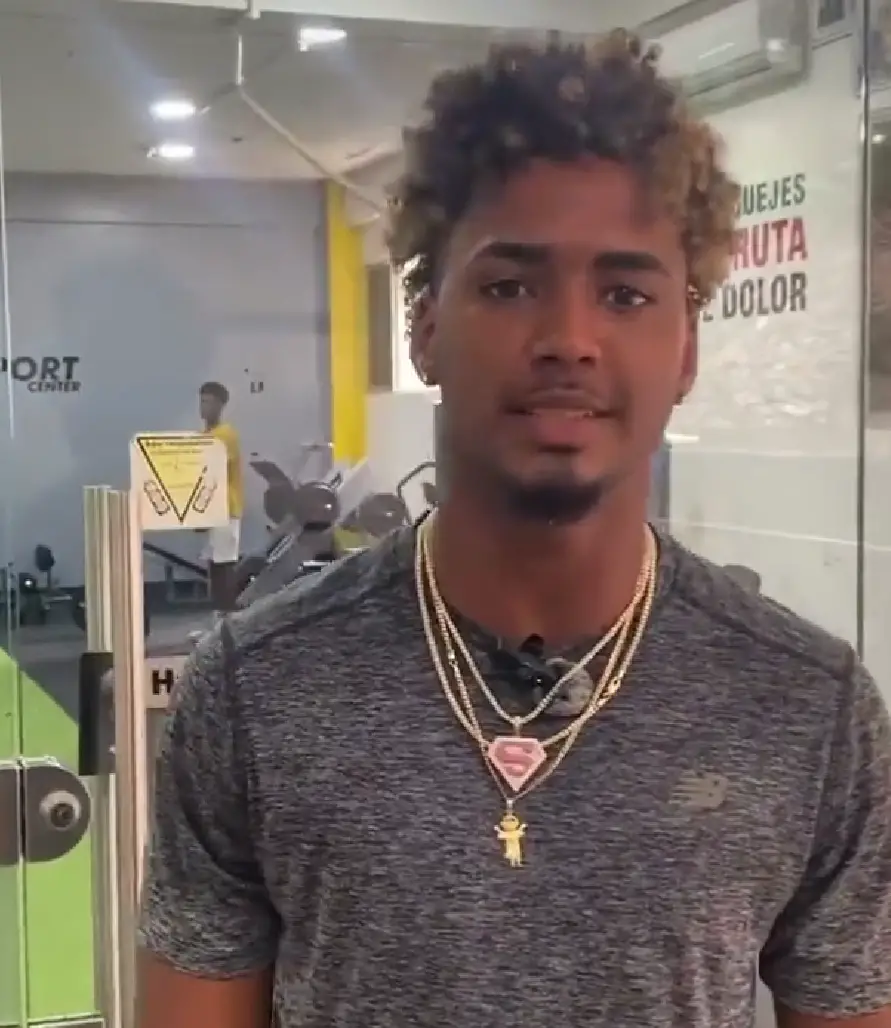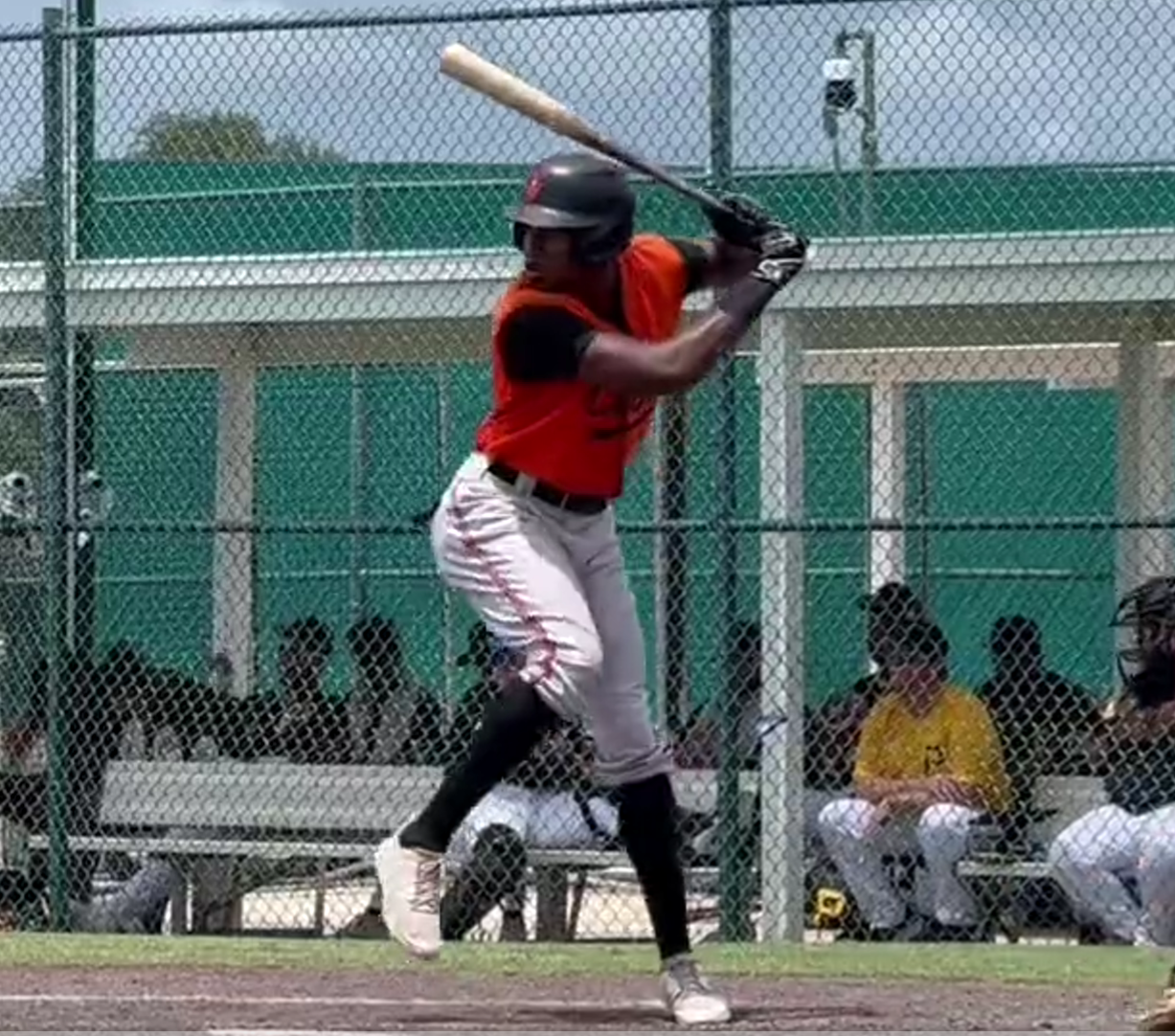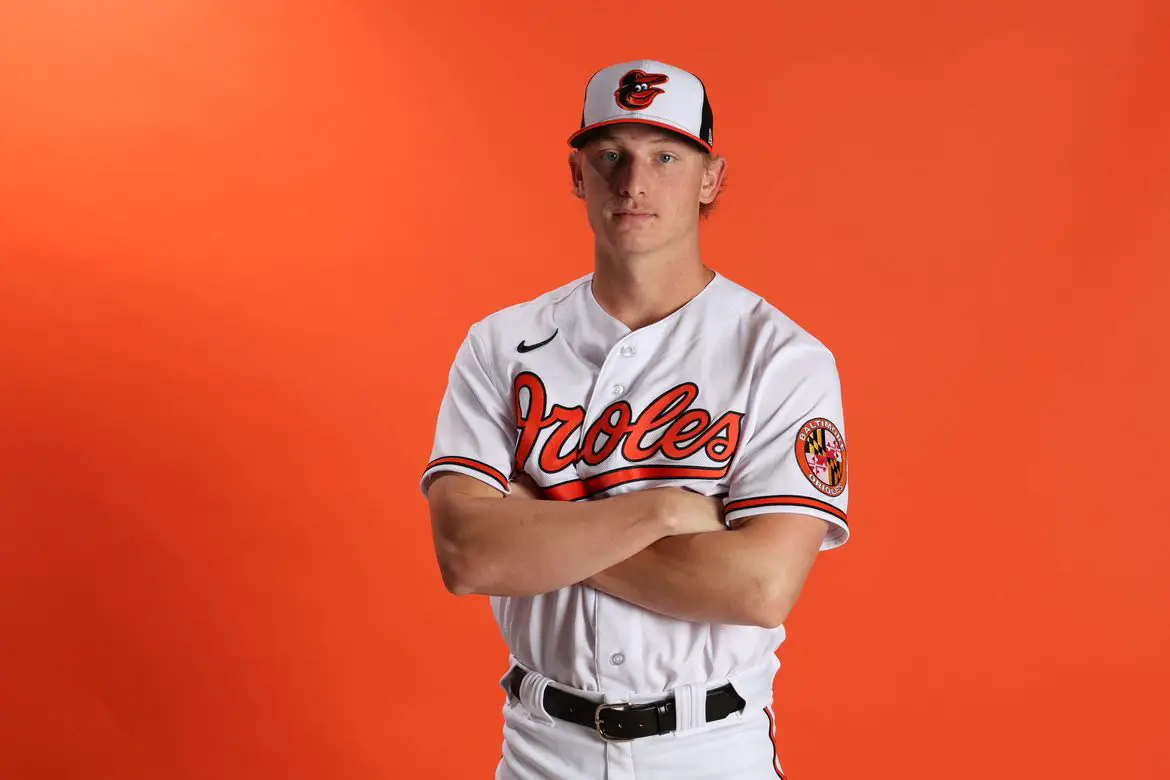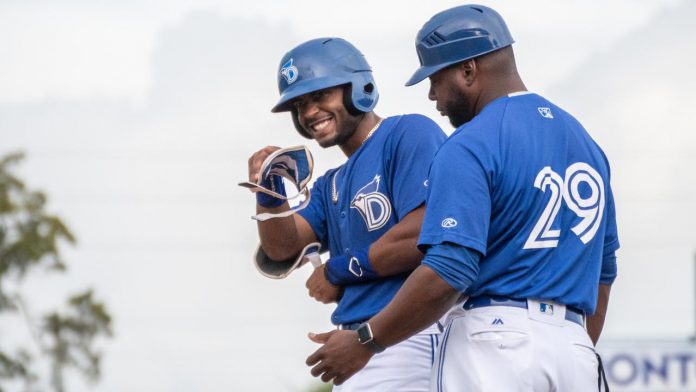This is not a top prospect list or an Orioles-specific list. This Rule 5 Draft preference list takes into consideration the concerns of carrying a player in the Majors all year and the effect that takes on a player’s development. So even for a pure rebuilding team, grabbing the most tooled up 20 year old SS struggling in A ball isn’t always a viable option. My rankings reflect both the likelihood of sticking with the drafting club and ability to provide value in the future. This is always a tough exercise and the deeper you dive, the more challenging it gets. This year was my deepest dive yet. It’s important to remember even the best available players are far from locks for MLB success, that’s why they were left unprotected.
1. Joshua Palacios – OF (Blue Jays)
Josh Palacios is at the top of this list because he is the player with the best chance of both surviving a season in the majors right now and possibly growing into an everyday role in the future. The 6’1″ lefty swinging outfielder has a well rounded toolset, that until this season was held back by a fatal flaw. Palacios, an above average runner, is a good defender at each of the corners but probably not a true CF. So his huge propensity for hitting the ball on the ground killed his profile. If you are a corner only fit or not average in center, you need to be able to hit for some power.
For Palacios, the problem wasn’t his raw power, but his ability to lift the ball in games. He was a pure slap hitter, with groundball rates up above 60%. He had a vertical bat at load and just dropped his hands to meet the ball. In the offseason he apparently made a change and came into 2019 with a different load. Now the knob of the bat is pointing towards the catcher and he turns the barrel and achieves a positive angle of attack on contact. This allowed his average raw power to play in game and reduced his groundball rate 18% from last year. He did this while keeping strikeouts under control and maintaining a patient late count approach.
The end result was a line 34% above league average in AA in his age 23 season. For a guy who can be an asset in a corner, play a passable CF, and add a little something on the basepath, that’s very interesting.
2. Wandisson Charles – RHP (A’s)
There are a number of high octane arms available in this year’s Rule 5 Draft. Most are either too raw, too wild, or lack a viable offspeed pitch. Charles most closely fits into the too wild category. He’s walked 7.93 per 9 in his MiLB career. It was down to 6.21 BB/9 in 2019, but he showed flashes of viable control, including a 3.14 BB/9 in 14.1 AA innings to finish off the season. There are other reasons to be optimistic as well. He was only 22 years old this season, he’s a big (6’6″) guy with long arms/legs, his mechanics work, and he’s pretty athletic for his size. For that reason, I believe he has a good chance to continue to improve his strikethrowing.
When he throws strikes, hitters struggle to catch up to his fastball which sits 97-99mph and will touch 101 and 102 at times. He releases the ball with good extension that adds even more difficulty to hitters trying to time him up. He’ll also flash a plus slider around 90mph with significant depth. It’s easy late inning stuff and worth the bet on his control ticking up as he matures.
3. Ka’ai Tom – OF (Indians)
Tom has made his way through the minors as a hard-working, grind it out style player. He’s never been much of a prospect. He lacks the speed for CF and he lacked the power for a corner spot. When you are trying to shed the tweener label, it doesn’t help when you’re 5′ 8″ tall.
He’s gradually added physicality over the years and while that’s slowed him down a bit, it’s turned him into a guy who can impact the game with his bat. As a corner outfield fit, he’s not the typical Rule 5 selection, but he hit a ton in AA and AAA this year with no glaring red flags. Of all the position players, I think he has the best chance to stick.
4. Joe Barlow – RHP (Rangers)
Barlow is has a 95-97mph fastball with a near vertical spin axis, above average spin, resulting in premium ride. It’s almost impossible for hitters to deal with at the top of the zone and hard to lay off because he has a sharp 12-6 curveball that mirrors the spin of the fastball and drops off the table. He’s going to miss bats in the majors, it’s just a matter of whether he can throw enough strikes. He struggles with his release point at times, but the combination of missing bats and generating a huge amount of infield fly balls will likely lead a team to select him.
5. Trevor Megill – RHP (Padres)
At 6’8″ with a high 3/4 release, Megill presents a pretty unique look for hitters. The stuff isn’t big for a reliever, 92-95mph fastball with a fringy slider and an average curveball. But he throws both breaking balls for strikes and everything plays up due to the plane and extension. His strikeout/walk numbers were near the top of the PCL leaderboard and with 50+ innings in AAA he’s ready for a big league shot. He lacks the upside of some of the other relievers here, but is the most MLB ready.
6. Steven Fuentes – RHP (Nationals)
Fuentes was suspended 50 games in August, which I think has kept him a bit under the radar. He’s not the most exciting arm, but as a back of the rotation/swingman type, he might be the best available option. He throws a sinker 90-94mph from a near horizontal arm slot. He has the present command to paint the bottom of the zone with it and guys pound it into the ground. His changeup looks identical to the sinker until it’s too late and the bottom drops out. He also has a fringy slider.
He’s been mostly a multi-inning reliever in his pro career, but he made 11 starts in AA at 22 years old this year and pitched extremely well, holding his stuff in the longer outings. The lack of a strong breaking ball and average velocity limits the ceiling, but his command, pitchability, and ability to limit hard contact make him a strong Rule 5 candidate.
7. Brandon Bailey – RHP (Astros)
Bailey can do a lot of things. He’s a 5 pitch guy, with a fastball, cutter, slider, curveball and changeup. He can really spin the ball, and I believe his fastball has the highest Bauer Units (RPM/MPH) of any available pitcher. This give the pitch big vertical hop and allows it to miss bats at the top of the zone despite only being a fringe average pitch velocity-wise. The problem is that he has fastball command issues and the pitch can really get squared up in the bottom half of the zone. All of his offspeed pitches can miss bats but his feel for each comes and goes. He’s being developed for a multi-inning relief role and I think if he’s used as a once through the order guy with a simplified repertoire, he could make the jump from AA.
8. Yonny Hernandez – INF (Rangers)
I may be out of my mind ranking him this highly, but I love Yonny. He has a short, quick swing with excellent bat control. He sprays the ball to all-fields and AA wasn’t much of a challenge for him at 21 years old. He’s a high motor player with plus speed who will steal a base. He’s never going to hit for enough power to be an everyday player, but every team could use a guy who provides strong infield defense up the middle and is very tough to strike out.
9. Luis Rijo – RHP (Twins)
This is pretty high for a guy who hasn’t pitched above A ball, but Rijo has a mature game on the mound. He has an above average to plus curveball that he lands for strikes and allows his fastball to play up. The fastball is into the mid 90s early in starts but he loses some velocity down to the 89-92 range later in outings. He pitched all of 2019 at 20 years old, so that should improve. He also throws a changeup that is a future average pitch. But the real draw here is his command. It’s average present command (rare for a guy this young) and will be above to plus at maturity. He has great rhythm to his mechanics and is an effortless strike-thrower. You use him in mop-up long relief this year and he might not even need to get sent back to the minors the following year, he’s that advanced.
10. Buddy Reed – CF (Padres)
Reed is an all-world athlete with poor bat control. He’s a MLB ready CF defender with a strong chance to save a bunch of runs there. He’s a plus runner and will help you on the bases. His make-up gets rave reviews and he even has average to above raw power. You select him for the speed and defense and you dream on the bat. He’s probably never going to hit, but something does click for him, the upside is significant.
11. Kurt Hoekstra – RHP (Braves)
Hoekstra is a conversion arm who is in his first full season of pitching. That makes it all the more impressive that he made it to AAA and performed pretty well at every level. He has a weird high arm circle delivery that shouldn’t work, but does. His signature pitch is a 10-4 curveball that legit scares right-handed batters. It’s an easy plus pitch and he already has some feel for landing it in the zone and dropping it for chases. The fastball is 92-95mph, t96 with unintentional cut. That hurts it’s effectiveness in my opinion, because he has nothing with armside movement. If he could fix the release to increase spin efficiency, I’d guess he’d get more velocity and command of the pitch as well as improvement the movement separation of the fastball and curveball.
12. Jose Fermin – 2B/SS (Indians)
I don’t like stashing as a Rule 5 technique. If you think you have to send a guy back to the minors for multiple years after their selection year, that’s taxing on the 40 man roster. Not to mention that the jump to the majors could hurt development. That’s why Wander Javier and that cohort aren’t ranked. I only ranked a couple of stash guys and they have traits that make them more feasible than the others.
Fermin is the first true stash (I think Rijo could survive in the pen). What makes him different is his plus bat to ball skills, his mature approach, and his reportedly excellent work ethic/make-up. Those features, along with speed and defense make him the best candidate for a stash. If his development survives the pick, he has the ceiling of an everyday SS or more likely an above average utility infielder.
13. Sam Clay – LHP (Twins)
Clay is just your run of the mill 70%+ ground ball rate pitcher. He throws a heavy ball in the 91-94mph range and add an average-ish slider and changeup that he paints at the bottom of the zone. All his pitches get hit on the ground and the offspeed stuff is good enough to miss a few bats. Not a big upside type, but along with Megill, probably one of the most likely to provide immediate middle relief value.
14. Jose Rojas – INF (Angels)
A short, stout lefty with good bat control and balance at the plate. Rojas has been old for every level, but you can’t ignore his production. He’s blasted 48 HRs in the last two seasons and hit well (120 wRC+) in AAA this year. The question mark is his defense, he plays some 2B and 3B as well as some 1B, LF. He’s not good at any of those positions, but his best chance to avoid a 1B/DH role is at 3B where his below average speed hurts him the least. If you think he can handle 3B in the majors, he’s a good pick, if not, there are a couple of other 1B types I’d prefer (Nogowski and Gittens). Color me skeptical.
15. Cam Hill – RHP (Indians)
The Indians have had a lot of success developing unheralded pitchers. Cam Hill fits that description as a 17th round pick who hasn’t made many prospect lists. But Hill has legit stuff, 94-96mph fastball, t97 with two above average offspeed pitches, a curveball and a split change. The fastball is a bit homer prone because it lacks horizontal movement and doesn’t have standout vertical rise, but I think that could be improved with increased offspeed usage. He’s missed a lot of time in recent years, so it’s possible this isn’t the best version of him yet. Nevertheless, not many guys strikeout 34% of the hitters they face in AAA.
16. Sterling Sharp – RHP (Nationals)
Sharp is a tall, thin, athletic sinkerballer. The pitch plays pretty well despite it’s lackluster velocity (89-91mph). It has plus sink/tail and generates groundballs at a high rate. He adds an above average change and a fringy slider. While he throws strikes, the command is fringe average. I have my doubts about the stuff playing as a rotation arm, but I could see him having value if the velocity increases in the pen.
17. Jared Robinson – RHP (Indians)
Robinson is a fairly typical reliever in today’s game. He has a 95-98mph fastball and an above average slider. He ran into some difficulties in his AAA debut, but Robinson will be a MLB pitcher at some point, it’s just whether a team thinks he’s ready and worth a pick now.
18. Hever Bueno – RHP (Rangers)
Bueno just turned 25 and hasn’t made it out of A ball, he has all of 79 pro innings pitched. Why is he on this list? Well, because he might have the best relief stuff available. Returning for TJS in 2019, Bueno touched 100mph with his fastball and flashed a plus curveball and an above average changeup. While he’s short of pro experience, he was a Pac-12 Friday night starter in college and if the command ticks up as he gets further removed from surgery, he could stick.
19. John Nogowski – 1B (Cardinals)
Nogowski’s best skill is his strike zone judgement. He’s a ridiculously discerning hitter and hits the ball to all fields. He walked 15 more times than he struck out in AAA. He’s only played 1B and he’s a right-handed hitter and he doesn’t have the power typically desired from 1B. The lack of positional flexibility really hurts his Rule 5 chances, but he’s a strong defender at 1B and I think he’s a low end regular if given a chance. He’s the highest probability to put up a league average batting line of all the available players.
20. Corbin Clouse – LHP (Braves)
A lefty with AAA experience and solid stuff, Clouse should generate some Rule 5 interest. Clouse offers a 92-95mph fastball from a standard 3/4 delivery. The pitch has some ride up in the zone and he locates it well armside. He also has an above average curveball. He ran into some HR issues with the juiced ball, but he’s what LH middle relief looks like.
21. Cody Thomas – OF (Dodgers)
Thomas is a tools bet with limited bat control. He’s a former multi-sport athlete with above average bat speed and plus raw power. He has a modern fly-ball oriented swing and if the bat to ball skills improve, there is considerable upside as an everyday RF where his speed and strong arm play well. He’ll probably struggle mightily at the major league level initially as a guy who has yet to see AAA or even dominate in AA, but there is a slight chance at everyday upside.
22. Chris Gittens – 1B (Yankees)
Gittens had one of the best seasons with the bat in the minors, putting up a 164 wRC+ in the Eastern League despite playing half his games in a pitcher’s park. Other than an injury riddled 2018, he’s hit a ton at every stop. He’s an late count hitter and runs a big walk (14.9%) and strikeout (29%) rate, despite a reasonable swinging strike rate. He’ll be hard to carry as a huge plodding right-handed hitting 1B/DH only guy who hasn’t seen any time in AAA, but there is some real upside in the bat. He hits the ball as harder the anyone in MiLB and if he could tweak his swing to lift the ball a little more, his home run totals could explode.
23. Moises Gomez – OF (Rays)
Unlike a lot of the young stash candidates, Gomez is physically mature. This physicality gives him a better chance in my opinion of surviving the year in the majors without severe development issues. Gomez has plus raw power and natural loft in his swing. He struggles with sequencing and zone recognition at times, but the swing works and should develop a viable hit tool eventually. Any team picking him would pretty much waste a roster spot for a year and then send him to the minors for another year or two, so it’s a commitment. But the ceiling is above average RF, so there may be a willing team.
24. Ryan Boldt – OF (Rays)
Boldt is coming off TJS, so he’s a bit of a question mark, but before his injury he was thriving in AA as a well rounded corner outfielder. He had a chance to become a low end regular back then and while he’s lost development time, he still has some everyday upside if he comes back at full strength.
25. Zack Brown – RHP (Brewers)
Brown has a prospect track record and performed at every level before reaching AAA in 2019. You’d expect that he’d be higher on this list. The problem is that his fastball was just 90-94mph and while it does have some sink, it gets exploited by modern positive attack angle swings that are becoming more and more common. That makes it hard to get to his above average curveball and changeup. A switch to a 4S fastball might or grip alteration might help things, but it looks more like a middle relief profile rather than the back of the rotation projection that put him on prospect lists.
26. Ian McKinney – LHP (Mariners)
A former MiLB free agent, McKinney has taken a big step forward in the Mariners system. The lefty sits 93-94 as a starter, t96 with hop. His offspeed stuff isn’t great, with a below average cutter, fringe average change, and an average curveball. That’s pretty serious left-handed starter velocity and he locates the fastball well in route to a dominant season in the California League. On the other hand, he’s 25 and has only pitched 15 innings above A+ ball. Still it might be the best left-handed fastball (considering velocity, movement, and command) available.
27. Tyler Cyr – RHP (Giants)
Cyr missed most of 2018 after having surgery to fix an elbow fracture. He came back in 2019 featuring the best stuff of his pro career. His fastball was 94-97mph t99, with an above average cutter in the low 90s and an average curveball. He strides towards 3B and throws across his body, adding some deception but limiting his command. The stuff is good enough to warrant consideration.
28. Jovani Moran – LHP (Twins)
A lefty that touches 96mph with a nasty changeup and a usable slider, Moran misses a ton of bats (18% swinging strike rate). He has strikethrowing issues, but he’s only 22 years old and improved down the stretch of his 2019 season in AA.
29. Dauris Valdez – RHP (Padres)
Huge, hard throwing righty will run the fastball up to 100mph. His slider and changeup both flash above average and he has an intimidating mound presence. His fastball plays below it’s velocity and there are command issues which limit his placement on this list.
30. Ljay Newsome – RHP (Mariners)
Four pitch command and feel righty without a real out pitch. Big time strikethrower, pounds the zone and relies on his deceptive whippy arm action to help his 89-93mph fastball play up. It might play in the majors as a 5th/6th starter type, but I’m not sure if a team wants to take a flyer on him until he’s proven it in AAA.
31. Eric Filia – 1B/COF (Mariners)
Filia is just coming off a 100 game suspension for a Drug of Abuse, his third violation. Rumors are that all the infractions were for marijuana, which was just dropped as a drug that they test for in the minors. Suspensions aside, Filia has done nothing but hit in his MiLB career. He has an unbelievable 1.6 BB/K ratio and his quick, balanced left-handed swing will give him a good chance to hit at the next level. The problem is that he doesn’t even have the power of Nogowski and doesn’t have a lot of defensive value.
32. Stephen Alemais – INF (Pirates)
Plus glove at either of the middle infield positions. Coming off a lost year due to a shoulder injury, but held his own in AA back in 2018. Not a lot of upside at the plate, but a patient hitter who takes professional ABs and will definitely save runs with his glove.
33. Jonathan Arauz – SS (Astros)
Arauz is a switch hitting shortstop who needs to give up switch hitting and stick to his LH swing which is more fluid and impactful. He splits time between 2B or SS and made it to AA in his age 20 season. He needs to get stronger and he’d be a stash selection, but there is a chance he’d grow into an everyday player, especially if he can stick at short.
34. Curtis Taylor – RHP (Blue Jays)
Curtis is a 96-99mph relief arm with an above average slider. It’s more control than command and he missed a bunch of time with a UCL sprain, so there’s a risk that the stuff doesn’t show up in 2020. If I knew he wouldn’t need TJS in the near future, he’d be 15+ spots higher.
35. Andy Ibáñez – INF (Rangers)
Generic brand Jose Rojas, Ibáñez hit well in AAA (112 wRC+) and has better contact skills than Rojas, but less power. Ibáñez has less upside, it’s utility only and he’s not a great defender, but he has the ability to play every infield position and would be easier to carry.
36. Anthony Misiewicz – LHP (Mariners)
Athletic lefty with a solid 4 pitch mix, some deception, but nothing above average. Fastball 90-93 at best, sometimes more 88-91. Survived the pitching hell that was the PCL in 2019, actually finished really strong down the stretch. One of the few workable choices for a team who wants someone to compete for a #5 starter spot.
37. Luis Carpio – INF (Mets)
I’ve always liked Carpio’s swing and he hit pretty well in AA as a 21/22 year old. He’s not a plus defender, but he can play either of the middle infield positions and I think there’s a chance he grows into fringe average power which would make him a potential low end regular.
38. Dany Jimenez – RHP (Blue Jays)
Late-blooming righty with a 96-98mph fastball and an average slider and changeup. Throws enough strikes for a MLB role back lacks the kind of command or offspeed stuff to be a late inning type and only has 33 innings above A+ ball.
39. Kyle Holder – SS (Yankees)
Glove first SS without much bat speed who makes the most of his tools at the plate. Has gotten more physical, but will likely struggle with MLB pitching. Utility candidate.
40. Andre Scrubb – RHP (Astros)
A poor man’s Joe Barlow, Scrubb also features a fastball/curveball combo from an even more vertical arm slot. Scrubb lacks the velocity of Barlow, more 92-95mph, and the sharpness of the curveball. But the fastball has premium ride (like Barlow) and curveball spin mirrors the fastball, so teams that seek out those traits could be interested.
41. Rafael Marchan – C (Phillies)
Small, agile defensive minded catcher with above average bat control. Would be much higher as a perfect glove first backup catcher if it wasn’t for the fact that he’s only 20 and spent the year between A and A+ ball. He’s a stash candidate, but I wonder if teams will see enough upside (he lacks power) to waste a roster spot on him.
42. TJ Friedl – OF (Reds)
Speed and defense guy who is recovering from ankle surgery. There are plenty of questions here, like how will he recover from the surgery and whether the arm plays in CF. If you think he’s a CF, he’s got enough contact ability and gap power to be a solid 4th OF, but like I said there are plenty of questions.
43. Brett Cumberland – C (Orioles)
A patient switch-hitter with above average raw power. He hit very well in an injury shortened 2019. If you think Cumberland can stick behind the plate, he’s worth a selection. His defense behind the plate leaves a lot to be desired though and he hasn’t played any other position as a pro.
44. Andrew Lee – RHP (Nationals)
Velocity was down a little in the AFL, but late in the season he was 92-95 as a starter with an average slider and average curveball. He cuts his fastball unintentionally I believe, which in his case helps it play up a bit. He’s really only on this list because he gives me faint Brad Keller vibes.
45. Daniel Alvarez – RHP (Yankees)
Alvarez has one weapon, a nasty two-plane slider that he has the feel to use extensively. His fastball is just 90-93 t95 with some natural cut gloveside. He’s pretty young (22/23 this year) and I could see a team being interested in seeing what happens if he throws the slider 50%+ of the time.
46. Forrest Wall – OF (Blue Jays)
I overrated him a bit last year, mistaking him for a CF fit when his arm only plays in LF. But he’s improved at the plate, hitting the ball with more authority. Still a bit of a tweener, but perhaps a useful one.
47. Jordan Sheffield – RHP (Dodgers)
Premium stuff, upper 90s with above average spin rates. Nasty high-spin curveball. He really belongs at the top of this list. The problem is that he can’t throw strikes, he’s not around the plate, he’s wild and mechanically inconsistent. Add that to his age (24), his less than ideal frame, and his high effort delivery and it paints a picture of someone who isn’t going to figure it out. A team that thinks they could fix him could take a flyer. If I thought there was a path to fix his issues, he’d be top 5 on this list, he looked lost on the mound.
48. Vimael Machin – INF (Cubs)
Machin can play all over the infield, including SS and makes a ton of contact. He’s 26 years old, barely played in AAA yet, and he doesn’t have much pop which limits his potential.
49. Oscar Gonzalez – OF (Indians)
A 21 year old with a chance to have hit and hit for power at maturity, a team may try and stash him away. His extremely aggressive approach isn’t close to MLB ready and he’s only a corner outfield fit, so it’d be a risky move.
50. Trenton Brooks – OF (Indians)
One of those limited tools grinder types who has been completely off the radar. Pretty much no way he gets picked, but I wanted to highlight a significant swing/approach change that led to a huge jump in pull side flyballs in AA. Pull side flyballs are a hitting cheat code that lets guys with fringe raw power have above average to plus game power. Most guys can’t do it without big swing and miss issues. Brooks did it in a limited sample size (264 PAs), but it resulted in a 143 wRC+ in AA.
50 more names (in rough order of preference per category)
Velocity/Stuff arms
Sam McWilliams
Dalbert Siri
Reid Anderson
Connor Jones
Yohan Ramirez
Carlos Sanabria
Wladimir Pinto
Jackson McClelland
Upside arms but too far away
Luis Oviedo
Resley Linares
Connor Bennett
Yerry De Los Santos
Luis Mota
Chance to start
Cody Sedlock
Rony Garcia
Luke Bachar
Griffin Jax
Matt Swarmer
Utility INF
Luke Williams
Hoy Jun Park
Miles Mastrobuoni
Eli White
Chad de la Guerra
Ivan Castillo
Bats that can also be 3rd catchers
Brett Sullivan
Cooper Hummel
Sluggers
Cristian Santana
Connor Joe
Roberto Ramos
Curtis Terry
Josh Ockimey
Vince Fernandez
Talented Stash
Lolo Sanchez
Ricardo Genoves
Esteury Ruiz
Wander Javier
Shervyton Newton
Garrett Whitley
Seuly Matias
Good Breaking Balls
Eduardo Bazardo
Gray Fenter
Jacob Lindgren
Dylan Lee
Thomas Burrows
Sidearm and Submariners
Quintin Torres-Costa
Jack Anderson
Tom Hackimer
Outfielders
Dom Thompson-Williams
Conner Capel
Carlos Rincon
